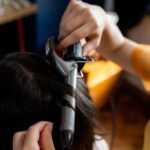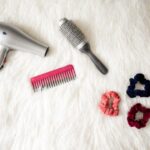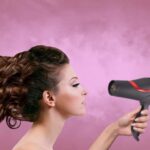Hair dryers can reach temperatures between 140°F to 300°F (60°C to 149°C), depending on the model. To minimize heat damage, choose a hair dryer with adjustable temperature settings and use proper techniques like towel-drying, sectioning, and using a concentrator nozzle.
Understanding Hair Dryer Temperature Ranges
Hair dryers can reach varying temperatures depending on their wattage and settings. Typically, they can produce heat from as low as 80°F (27°C) to as high as 450°F (232°C). The temperature range depends on the hair dryer’s power, design, and features.
Table: Typical Hair Dryer Temperature Ranges
| Wattage Range | Temperature Range |
|---|---|
| 800-1200 | 80°F (27°C) – 300°F (149°C) |
| 1200-1875 | 300°F (149°C) – 450°F (232°C) |
“Hair dryers can produce heat from as low as 80°F (27°C) to as high as 450°F (232°C), depending on their wattage and settings.”
Temperature Settings and Hair Types
Choosing the right temperature setting is crucial for minimizing heat damage and achieving the best styling results. Different hair types require different heat settings:
Fine Hair
Fine hair is delicate and prone to heat damage. Use lower temperature settings, typically around 150-300°F (65-150°C), to protect your hair.
Medium/Normal Hair
Medium hair can withstand slightly higher temperatures than fine hair. Opt for settings between 300-350°F (150-180°C) for effective styling without causing damage.
Thick or Coarse Hair
Thick or coarse hair requires higher temperatures to achieve the desired style. Use settings between 350-400°F (180-205°C) for efficient styling. Some hair dryers have a “high” setting specifically for this hair type.
Table: Hair Types and Recommended Temperature Settings
| Hair Type | Recommended Temperature Range |
|---|---|
| Fine Hair | 150-300°F (65-150°C) |
| Medium Hair | 300-350°F (150-180°C) |
| Thick/Coarse Hair | 350-400°F (180-205°C) |
“Different hair types require different heat settings, ranging from 150°F (65°C) for fine hair to 400°F (205°C) for thick or coarse hair.”
Importance of Temperature Control
Temperature control is essential for achieving the desired hairstyle while minimizing the risk of heat damage. Modern hair dryers often come with adjustable temperature settings to cater to various hair types and styles.
Consistent Heat Distribution
An even heat distribution throughout your hair ensures consistent results and prevents damage caused by excessive heat in specific areas.
Customization for Hair Types
As mentioned earlier, different hair types require different temperatures. Adjustable temperature settings allow you to customize the heat according to your hair type and desired style.
Minimizing Heat Damage
Using the appropriate temperature for your hair type and style prevents excessive heat exposure, reducing the risk of heat damage.
Table: Importance of Temperature Control
| Aspect | Benefit |
|---|---|
| Consistent Heat Distribution | Ensures even styling results and prevents damage |
| Customization for Hair Types | Allows for personalized heat settings based on hair type |
| Minimizing Heat Damage | Reduces the risk of damage due to excessive heat |
“Temperature control is essential for consistent heat distribution, customization for hair types, and minimizing heat damage.”
Heat Safety Tips for Hair Dryer Use
When using a hair dryer, it’s essential to follow some basic heat safety tips to protect your hair and scalp from heat damage.
- Use a heat protectant spray: Apply a heat protectant spray to your hair before using a hair dryer. This helps shield your hair from excessive heat and reduces the risk of damage.
- Don’t use the highest setting: Unless you have very thick or coarse hair, avoid using the highest heat setting on your hair dryer. Stick to lower temperatures to protect your hair.
- Maintain a safe distance: Keep the hair dryer at least 6 inches (15 cm) away from your head to avoid burning your scalp or hair.
- Keep the hair dryer moving: Don’t focus the heat on one area for too long. Constantly move the hair dryer to distribute heat evenly and prevent damage.
- Don’t over-dry your hair: Over-drying your hair can lead to brittleness and breakage. Stop using the hair dryer once your hair is about 80-90% dry.
Table: Heat Safety Tips for Hair Dryer Use
| Tip # | Heat Safety Tip |
|---|---|
| 1 | Use a heat protectant spray |
| 2 | Don’t use the highest setting |
| 3 | Maintain a safe distance |
| 4 | Keep the hair dryer moving |
| 5 | Don’t over-dry your hair |
“Follow heat safety tips such as using a heat protectant spray, maintaining a safe distance, and not over-drying your hair to minimize heat damage.”
Comparing Temperature Output of Various Hair Dryers
Different hair dryers have varying temperature outputs, which can significantly impact their performance and potential for causing heat damage. Here are some common types of hair dryers and their temperature ranges:
Traditional Hair Dryers
Traditional hair dryers usually have a temperature range of 140°F to 200°F (60°C to 93°C). These models may not have adjustable temperature settings, making it difficult to customize the heat based on your hair type.
Ceramic Hair Dryers
Ceramic hair dryers typically offer temperatures between 180°F to 225°F (82°C to 107°C). They use ceramic heating elements to provide even and consistent heat distribution, which helps reduce the risk of heat damage.
Tourmaline Hair Dryers
Tourmaline hair dryers can reach temperatures of 200°F to 250°F (93°C to 121°C). These models use tourmaline-infused components to emit negative ions, reducing frizz and enhancing shine while maintaining a safe temperature range.
Ionic Hair Dryers
Ionic hair dryers offer temperature settings ranging from 180°F to 300°F (82°C to 149°C). These hair dryers produce negative ions to break down water molecules, allowing faster drying at lower temperatures and reducing heat damage.
Table: Temperature Output of Various Hair Dryers
| Hair Dryer Type | Temperature Range (°F) | Temperature Range (°C) |
|---|---|---|
| Traditional | 140 – 200 | 60 – 93 |
| Ceramic | 180 – 225 | 82 – 107 |
| Tourmaline | 200 – 250 | 93 – 121 |
| Ionic | 180 – 300 | 82 – 149 |
Minimizing Heat Damage with Proper Technique
Using the correct techniques when using a hair dryer can significantly minimize heat damage to your hair. Here are some tips for safe and effective hair drying:
- Towel-dry your hair first: Gently towel-dry your hair before using a hair dryer to remove excess moisture, reducing the amount of heat exposure.
- Section your hair: Divide your hair into sections and dry one section at a time. This ensures even heat distribution and prevents over-drying.
- Hold the hair dryer correctly: Hold the hair dryer at a downward angle to avoid frizz and help the hair cuticle lay flat.
- Use a concentrator nozzle: Attach a concentrator nozzle to your hair dryer for precise airflow, reducing the risk of heat damage.
- Finish with a cool shot: Use the cool shot button on your hair dryer to set your hairstyle and close the hair cuticles, locking in moisture and shine.
Table: Minimizing Heat Damage with Proper Technique
| Tip # | Technique for Minimizing Heat Damage |
|---|---|
| 1 | Towel-dry your hair first |
| 2 | Section your hair |
| 3 | Hold the hair dryer correctly |
| 4 | Use a concentrator nozzle |
| 5 | Finish with a cool shot |
Key Takeaways
- Hair dryers can reach a wide range of temperatures, with traditional hair dryers usually providing less temperature control than ceramic, tourmaline, and ionic models.
- The appropriate temperature setting depends on your hair type and condition, with finer and more delicate hair requiring lower heat settings.
- Temperature control is essential to prevent heat damage and achieve optimal results while using a hair dryer.
- Use proper techniques when drying your hair, such as towel-drying first, sectioning your hair, and using a concentrator nozzle to minimize heat damage.
- Be aware of the differences between various types of hair dryers, and choose one that best suits your needs and offers customizable temperature settings.
Conclusion
Understanding how hot hair dryers get is crucial for protecting your hair from heat damage and achieving the best styling results. Different hair dryers have various temperature ranges, with ceramic, tourmaline, and ionic models generally providing better heat control. Remember to select the appropriate temperature setting based on your hair type and use proper techniques when drying your hair to minimize heat damage.









